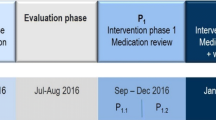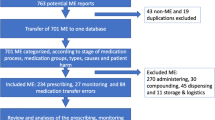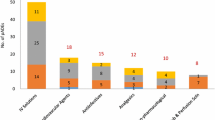Abstract
Background Operating rooms and Intensive Care Units are places where an optimal management of drugs and medical devices is required. Objective To evaluate the impact of a dedicated pharmacist in an academic Anaesthesiology and Critical Care Department. Setting This study was conducted in the Anaesthesiology and Critical Care Department of Grenoble University Hospital. Method Between November 2013 and June 2017, the drug-related problems occurring in three Intensive Care Units and their corrections by a full-time clinical pharmacist were analyzed using a structured order review instrument. Pharmaceutical costs in the Anaesthesiology and Critical Care Department were analyzed over a 7 year period (2010–2016), during which automated dispensing systems and recurrent meetings to review indications of medications and medical devices were implemented in the department. Main outcome measure Analysis of two issues: correcting drug-related problems and containing pharmaceutical costs. Results A total of 324 drug-related problems were identified. The most frequent problem concerned anti-infective agents (45%), and this was mainly due to the over-dosage of drugs (30%). Dosage adjustments were the most frequent interventions performed by the pharmacist (43%). Over the 7 year period, pharmaceutical costs decreased by 9% (€365,469), while the care activity of the department increased by 55% (+ 12,022 surgical procedures and + 1424 admissions in the ICU). Conclusion Integrating a pharmacist into the Anaesthesiology and Critical Care Department was associated with interventions to correct drug-related problems and containing pharmaceutical costs. Pharmacists should play a central role in such medical environments, to optimize the use of drugs and medical devices.


Similar content being viewed by others
References
Kane-Gill SL, Kirisci L, Verrico MM, Rothschild JM. Analysis of risk factors for adverse drug events in critically ill patients. Crit Care Med. 2012;40(3):823–8.
Brilli RJ, Spevetz A, Branson RD, Campbell GM, Cohen H, Dasta JF, Harvey MA, Kelley MA, Kelly KM, Rudis MI, St Andre AC, Stone JR, Teres D, Weled BJ. American college of critical care medicine task force on models of critical care delivery. The american college of critical care medicine guidelines for the definition of an intensivist and the practice of critical care medicine. Crit Care Deliv Intensive Care Unit Defin Clinl Roles Best Pract Model Crit Care Med. 2001;29(10):2007–19.
Rudis MI, Brandl KM. Position paper on critical care pharmacy services. Crit Care Med. 2000;28:3746–50.
Erstad B. A primer on critical care pharmacy services. Ann Pharmacother. 2008;42:1871–81.
Leape LL, Cullen DJ, Clapp MD, Burdick E, Demonaco HJ, Erickson JI, et al. Pharmacist participation on physician rounds and adverse drug events in the intensive care unit. JAMA. 1999;282(3):267–70.
Marshall J, Finn CA, Theodore AC. Impact of a clinical pharmacist-enforced intensive care unit sedation protocol on duration of mechanical ventilation and hospital stay. Crit Care Med. 2008;36(2):427–33.
Kane SL, Weber RJ, Dasta JF. The impact of critical care pharmacists on enhancing patient outcomes. Intensive Care Med. 2003;29(5):691–8.
Klopotowska JE, Kuiper R, van Kan HJ, de Pont AC, Dijkgraaf MG, Lie-A-Huen L, et al. On-ward participation of a hospital pharmacist in a Dutch intensive care unit reduces prescribing errors and related patient harm: an intervention study. Crit Care. 2010;14(5):R174.
Kopp BJ, Mrsan M, Erstad BL, Duby JJ. Cost implications of and potential adverse events prevented by interventions of a critical care pharmacist. Am J Health Syst Pharm. 2007;64(23):2483–7.
MacLaren R, Bond CA, Martin SJ, Fike D. Clinical and economic outcomes of involving pharmacists in the direct care of critically ill patients with infections. Crit Care Med. 2008;36(12):3184–9.
Leguelinel-Blache G, Nguyen TL, Louart B, Poujol H, Lavigne JP, Roberts JA, Muller L, Kinowski JM, Roger C, Lefrant JY. Impact of quality bundle enforcement by a critical care pharmacist on patient outcome and costs. Crit Care Med. 2018;46(2):199–207.
Hartmann M, Meier-Hellmann A. How to increase return on investment of the intensive care pharmacist-fear of flying. Intensive Care Med. 2006;32(4):511–5.
ASHP guidelines on surgery and anesthesiology pharmaceutical services. American society of health-system pharmacists. Am J Health Syst Pharm. 1999;56(9):887–95.
Dezia AL, Baccus TD, Natavio AM, Conroy SM, Hall LM. Implementation of a pharmacist-led patient-controlled analgesia dosing service. Pain Pract. 2017;17(8):990–8.
Thomas JA, Martin V, Frank S. Improving pharmacy supply-chain management in the operating room. Healthc Financ Manag. 2000;54(12):58–61.
van Mil JW, Westerlund LO, Hersberger KE, Schaefer MA. Drug-related problem classification systems. Ann Pharmacother. 2004;38(5):859–67.
Bedouch P, Sylvoz N, Charpiat B, Juste M, Roubille R, Rose FX, et al. French society of clinical pharmacy’s act-IP© group. Trends in pharmacists’ medication order review in French hospitals from 2006 to 2009: analysis of pharmacists’ interventions from the act-IP© website observatory. J Clin Pharm Ther. 2015;40(1):32–40.
Bedouch P, Charpiat B, Conort O, Rose FX, Escofier L, Juste M, et al. Assessment of clinical pharmacists’ interventions in French hospitals: results of a multicenter study. Ann Pharmacother. 2008;42(7):1095–103.
Askari M, Eslami S, Louws M, Wierenga PC, Dongelmans DA, Kuiper RA, et al. Frequency and nature of drug–drug interactions in the intensive care unit. Pharmacoepidemiol Drug Saf. 2013;22(4):430–7.
Rivkin A, Yin H. Evaluation of the role of the critical care pharmacist in identifying and avoiding or minimizing significant drug–drug interactions in medical intensive care patients. J Crit Care. 2011;26(1):104.e1–6.
Shulman R, McKenzie CA, Landa J, Bourne RS, Jones A, Borthwick M, et al. Protected-UK group. Pharmacist’s review and outcomes: treatment-enhancing contributions tallied, evaluated, and documented (protected-UK). J Crit Care. 2015;30(4):808–13.
Rudall N, McKenzie C, Landa J, Bourne RS, Bates I, Shulman R. Protected-UK—clinical pharmacist interventions in the UK critical care unit: exploration of relationship between intervention, service characteristics and experience level. Int J Pharm Pract. 2017;25(4):311–9.
Patel G, Loh-Trivedi M. Clinical pharmacists in the intensive care unit: is there really an equation? Intensive Care Med. 2006;32(8):1275–6 author reply 1277.
Kanji S, Lam J, Johanson C, Singh A, Goddard R, Fairbairn J, et al. Systematic review of physical and chemical compatibility of commonly used medications administered by continuous infusion in intensive care units. Crit Care Med. 2010;38(9):1890–8.
Chapuis C, Roustit M, Bal G, Schwebel C, Pansu P, David-Tchouda S et al. Automated drug dispensing system reduces medication errors in an intensive care setting. Crit Care Med. 2010;38:2275–81.
Chapuis C, Bedouch P, Detavernier M, Durand M, Francony G, Lavagne P, et al. Automated drug dispensing systems in the intensive care unit: a financial analysis. Crit Care. 2015;19:318.
Orser BA, Hyland S, David U, Sheppard I, Wilson CR. Review article: improving drug safety for patients undergoing anesthesia and surgery. Can J Anaesth. 2013;60(2):127–35.
Bell CM, Brener SS, Gunraj N, Huo C, Bierman AS, Scales DC, et al. Association of ICU or hospital admission with unintentional discontinuation of medications for chronic diseases. JAMA. 2011;306(8):840–7.
Abdul-Aziz MH, Lipman J, Akova M, Bassetti M, De Waele JJ, Dimopoulos G, et al. DALI study group. Is prolonged infusion of piperacillin/tazobactam and meropenem in critically ill patients associated with improved pharmacokinetic/pharmacodynamic and patient outcomes? An observation from the defining antibiotic levels in intensive care unit patients (DALI) cohort. J Antimicrob Chemother. 2016;71(1):196–207.
Preslaski CR, Lat I, MacLaren R, Poston J. Pharmacist contributions as members of the multidisciplinary ICU team. Chest. 2013;144(5):1687–95.
Acknowledgements
The authors wish to thank the nurses and physicians in our department, for their enthusiasm and professionalism throughout the care of their patients.
Author information
Authors and Affiliations
Corresponding author
Ethics declarations
Funding
This study received no specific funding.
Conflicts of interest
The authors have no conflicts of interest to disclose.
Additional information
Publisher's Note
Springer Nature remains neutral with regard to jurisdictional claims in published maps and institutional affiliations.
Rights and permissions
About this article
Cite this article
Chapuis, C., Albaladejo, P., Billon, L. et al. Integrating a pharmacist into an anaesthesiology and critical care department: Is this worthwhile?. Int J Clin Pharm 41, 1491–1498 (2019). https://doi.org/10.1007/s11096-019-00909-0
Received:
Accepted:
Published:
Issue Date:
DOI: https://doi.org/10.1007/s11096-019-00909-0




